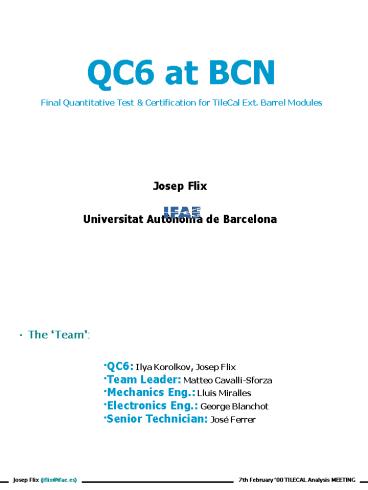QC6 at BCN - PowerPoint PPT Presentation
1 / 12
Title: QC6 at BCN
1
QC6 at BCN Final Quantitative Test
Certification for TileCal Ext. Barrel Modules
Josep Flix Universitat Autònoma de Barcelona
The Team
QC6 Ilya Korolkov, Josep Flix Team Leader
Matteo Cavalli-Sforza Mechanics Eng. Lluis
Miralles Electronics Eng. George
Blanchot Senior Technician José Ferrer
7th February 00 TILECAL Analysis MEETING
Josep Flix (jflix_at_ifae.es)
2
1/10
Motivation Whats QC6 at BCN?
Whats Quality Control?
? QC6, or Optical Quality Control, is the final
step to verify the acceptance of a Tilecal
module produced.
Correcting construction problems
Why QC and NOT Calibration?
? It is NOT possible to perform an absolute
calibration at each construction site to be
applied to the Tilecal operation in ATLAS.
Modules have to be shipped (Shocks Vibrations)
1 QC drawer for all modules (Different Couplings
from the final ATLAS Setup)
? Final calibration of modules will be done at
CERN with the Cs system.
Using a Blue Light Source for QC6
? A Blue Light Source simulates the blue light
caused by Scintillator.
? A comparison with Cs137 showed good correlation
(9). (No scintillation in Tiles)
? The LED system inexpensive and easy to use for
QC purposes.
Josep Flix (jflix_at_ifae.es)
http//wwwpc.ifae.es/jflix/qc6/home.html
3
2/10
1/2
QC6 Experimental Setup at IFAE
The Extender Machine
(Mechanics designed by Lluis Miralles) (Electronic
s to control it designed by George Blanchot)
? The machine responsible for the horizontal
motion of the LED inside the module and the
vertical motion between Tilerows is called
Extender".
Extender
LED
? VxLED in (0.1-100.0)mm/s range (DC Motor).
? Good Velocity stability ? ?VxLED/VxLED
0.3.
Josep Flix (jflix_at_ifae.es)
http//wwwpc.ifae.es/jflix/qc6/home.html
4
3/10
2/2
QC6 Experimental Setup at IFAE
The light Source
3 mm Window
Black Ink
Plastic Cylinder filled with Epoxy
Blue LED
? The BCN light source consists of a Blue LED
(NSPB-310A from NICHIA) and a diffuser
mounted on the top of the LED. ?
Azimuthal uniformity of emitted light 1-2
? ? amount of light yield ? Minimum Gain of
3in1can be used. ? ?peak 470 nm ? No
Scintillation Proccess in Tiles (only on WLS
Fibers).
Scintillator
Spacer
Master
Josep Flix (jflix_at_ifae.es)
http//wwwpc.ifae.es/jflix/qc6/home.html
5
4/10
DAQ and Reconstruction
Data Acquisition
? LabView 5.0 is used as the platform for DAQ. ?
Two external executables written in C are
called from the LabView shell. ? Another LabView
based program (qbench) is used to set and monitor
the PMT Voltages (provided by Clermont
People).
DAQ Parameters
? Lowest Gain on 3in1 Cards used. (R 7.5 M?)
? DAQ Frequency 75 Hz
sampling of 2 points/mm.
? LED Velocity 37.5 mm/s
DAQ Time 22 minutes/module
Reconstruction Software
? An executable written in Fortran is responsible
for the reconstruction of the data. It
generates two Ntuples, histograms and a File with
a list of the Optical Problems.
? An integral for every Tile-Fiber Coupling
response is calculated after pedestal
substraction.
? The Optical Problems are detected and its
potencial origins are suggested.
Josep Flix (jflix_at_ifae.es)
http//wwwpc.ifae.es/jflix/qc6/home.html
6
5/10
7
Josep Flix (jflix_at_ifae.es)
http//wwwpc.ifae.es/jflix/qc6/home.html
8
6/10
1/2
How Do We Flag Optical Problems an Example
1? Make a complete Scan for the constructed
module.
2? An automatic algorithm finds the integral for
every peak, that is, for every
Tile-Fiber-PMT Coupling ( Ij ).
3? The integral Value as a mean value of
individual peak responses for every
TileRow and Cell is calculated (ltIgt).
4?Looking for Optical Problems we use a Drop
variable (1- Ij/ltIgt)100 Dr
5?We flag all cases with a Drops above certain
threshold (), and we try to repair, at
least, those with drops gt30.
6?Go to 1?, until the problems have been solved.
Ij
ltIgt
Josep Flix (jflix_at_ifae.es)
http//wwwpc.ifae.es/jflix/qc6/home.html
9
7/10
2/2
Routing Problem (were Re-Routed)
Fibers Not arriving to the bundle End (were
Spliced)
Coupling Problems (D4 was Re-routed)
Before Splicing
After Splicing
Josep Flix (jflix_at_ifae.es)
http//wwwpc.ifae.es/jflix/qc6/home.html
10
8/10
System Studies
Sources of instrumental Errors
?Instabilities on LED Light Yield ?I, ?2?.
(1-2 uniformity in 2?)
?Instabilities on HV.
(?HV/HV 0.25 ? ?G/G 1.5 )
?Instabilities on PMT gains Drifts.
(Unknown yet)
?Instabilities on VLED.
(?V/V 0.3 )
?Instabilities on Electronics ?noise.
(?noise 0.42 ? 0.08 ADC Counts)
?Reconstruction error.
(?rec 0.05 ? 0.02 on drops)
Repeteability Measurements
?Repeteability for Inidividual Peak Response 1.5
? 0.3
?Repeteability for Drop Variable 0.6 ? 0.2
?Our errors comes mainly from the Light Source
(?I, ?2?) and from instabilities on HV.
We expect to improve the repeteability error for
the next modules.
Josep Flix (jflix_at_ifae.es)
http//wwwpc.ifae.es/jflix/qc6/home.html
11
9/10
What has been Repaired for the modules IFA001 ?
IFA005
Repairs module by module
Remaining Problems (Drop Threshold at 30)
Josep Flix (jflix_at_ifae.es)
http//wwwpc.ifae.es/jflix/qc6/home.html
12
10/10
Conclusions Outlook
Conclusions
?The production at BCN has been started and 5
modules have been instrumented and tested at
IFAE.
?The BCN QC6 System has been constructed, tested
and it is working with a repeteability of
0.6 on Drop variable. It is used to identify
and to flag the Optical Problems.
Observations
? Damaging of the insertion Tool. A reforced
new one has been constructed.
? Alternative to splicing the use of a Teflon
Tube glued at the Asp. Tube.
?No correlation between cracks and Fiber
Problems flagged.
?The BCN Production monitor Webpage
http//wwwpc.ifae.es/jflix/qc6/home.html
Outlook
?To follow instrumenting testing modules! (at
least, 60 more...)
?Study uniformity comparisons module-to-module.
?How the transport affects to the modules? Look
to Cs CERN Scans.
?Finalise test the Gain Monitor.
Josep Flix (jflix_at_ifae.es)
http//wwwpc.ifae.es/jflix/qc6/home.html































